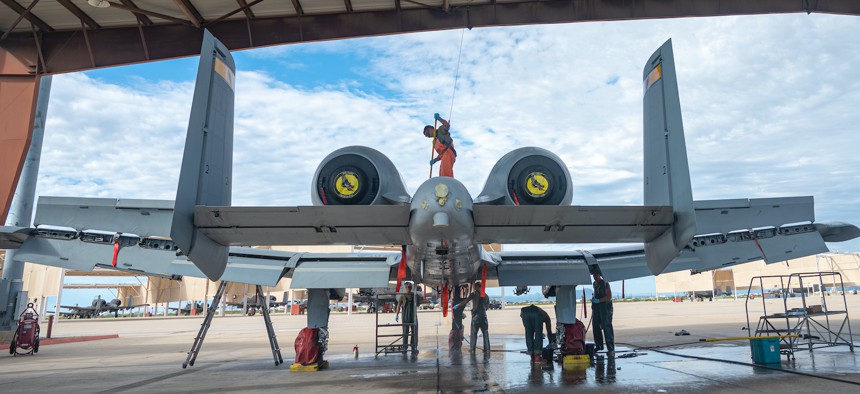
The A-10C Thunderbolt II Demonstration Team washes an A-10 Thunderbolt II at Davis-Monthan Air Force Base, Arizona, Oct. 6, 2022. U.S. Air Force / Staff Sgt. Jacob T. Stephens
Defense Business Brief: Budget bullet-points; Aircraft arrivals; Let’s kill ‘dead on arrival’; and more...
Happy (continuation of) budget week! You’re getting the newsletter a little late today because, well, there’s a lot happening right now. And with that, we’re off!
So far the reaction to the Biden administration's $842 billion fiscal 2024 defense budget request is much like the porridge in the fairy tale “Goldilocks and the Three Bears.” Defense-hawk Republicans think it's too little, progressives and far-right Republicans think it's too much, and moderate Democrats think it’s juuuuuuuuuust right!
Allow me to get on my soapbox: One of my biggest pet peeves surrounding the release of the White House budget proposal is that the opposition party—if they control at least one house of Congress—immediately declares the request “dead on arrival.” Both parties do it because it’s a quick sound bite guaranteed to get on the nightly news.
In reality, Congress always modifies the Pentagon’s sending request to some extent, and this year will be no exception. But just as certain is that the vast majority of what’s in the Pentagon’s tens of thousands of pages of budget justification documents that were electronically sent to lawmakers today will inevitably become law later this year (or next depending on) when Congress passes authorization and appropriations bills. “Dead on arrival” proclamations generate needless heat, not useful light.
OK, back to our regularly scheduled program. Here’s a recap of Defense One budget coverage thus far:
- An overview of topline numbers.
- Here are some major program highlights within the budget proposal.
- The Pentagon wants to boost science and technology spending, but China still appears to have the lead in some areas.
- The Air Force wants retire the A-10 faster than previously planned—and that’s not the only plane it wants to retire to free up cash for higher-priority projects.
- The Air Force wants to ditch plans for a new F-35 engine.
- The Army is looking to boost missile production and research-and-development spending.
Welcome
You’ve reached the Defense Business Brief by Marcus Weisgerber. Send along your tips, feedback and interesting items you’ve found in the budget to mweisgerber@defenseone.com or @MarcusReports. Check out the Defense Business Brief archive here, and tell your friends to subscribe!
The Boeing-Leonardo MH-139 helicopter has been deemed ready for low-rate initial production, Air Force acquisition chief Andrew Hunter announced last week. The Grey Wolf will replace the Huey helicopters that transport security forces around the vast nuclear missile sites in the northern United States.
Pacific Air Forces Commander Gen. Kenneth Wilsbach pushed hard to buy the E-7 Wedgetail radar plane to replace the decades-old, and often broken, E-3 AWACS aircraft. Now that the Air Force is buying the Boeing-made planes, Wilsbach wants to make sure he gets them on time. “I want it fast,” he said during a roundtable discussion with reporters at an Air and Space Forces Association conference in Colorado. He was scheduled to stop Boeing “to talk to them about making the E-7 as fast as they can make them because I want them very quickly.”
Oshkosh has protested the Army’s decision to buy tens of thousands of Joint Light Tactical Vehicles from AM General. Oshkosh is building JLTVs for the Army now, but the service had always intended to re-bid the contract. “After participating in the government’s post-award debriefing process, we have significant concerns regarding the evaluation of the proposals under the solicitation that support an independent review,” Tim Bleck, senior vice president Oshkosh Corporation and president Oshkosh Defense, said in a statement. “We believe the Government’s evaluation did not properly review the financial, technical, and manufacturing capabilities offered to select the best value and lowest risk solution to deliver the JLTV.” The Government Accountability Office, which reviews bid protests, has until June 14 to make a ruling.
Tuesday is the Reagan Institute’s National Security Innovation Base summit. The event, in Washington, D.C. I’ll be there moderating a panel about accessing innovation capital, which is a timely discussion in light of the Silicon Valley Bank collapse last week.
The Reagan Institute released its first National Security Innovation Base Report Card report card, which is being billed as “an innovative policy tool to measure the effectiveness, productivity, and resilience of our nation’s innovation ecosystem and provide recommendations for improvement.”
The report card’s advice for the Pentagon:
- “Foster stronger relationships with the private investment community.
- “Scale up workforce development programs to increase domestic STEM output and skilled trades.
- “Establish additional mechanisms to increase the foreign talent pipeline for critical national security technologies.
- “Create additional technology-focused international alliances and partnerships.
- “Make bigger, bolder, more flexible investments in new capabilities.”
Wednesday is Jim McAleese’s annual Defense Programs conference, also in D.C.
Boeing and Shield AI have signed a pact “to explore strategic collaboration in the areas of autonomous capabilities and artificial intelligence on current and future defense programs.” AI is one of the key technology focus areas for Boeing defense CEO Ted Colbert.
Making Moves
- Retired Air Force Gen. David Goldfein has joined Shield Capital’s National Security Advisory Board.
- General Dynamics has named Antonio Bueno, president of General Dynamics European Land Systems. He will replace Alfonso Ramonet, who intends to retire at the end of March.




